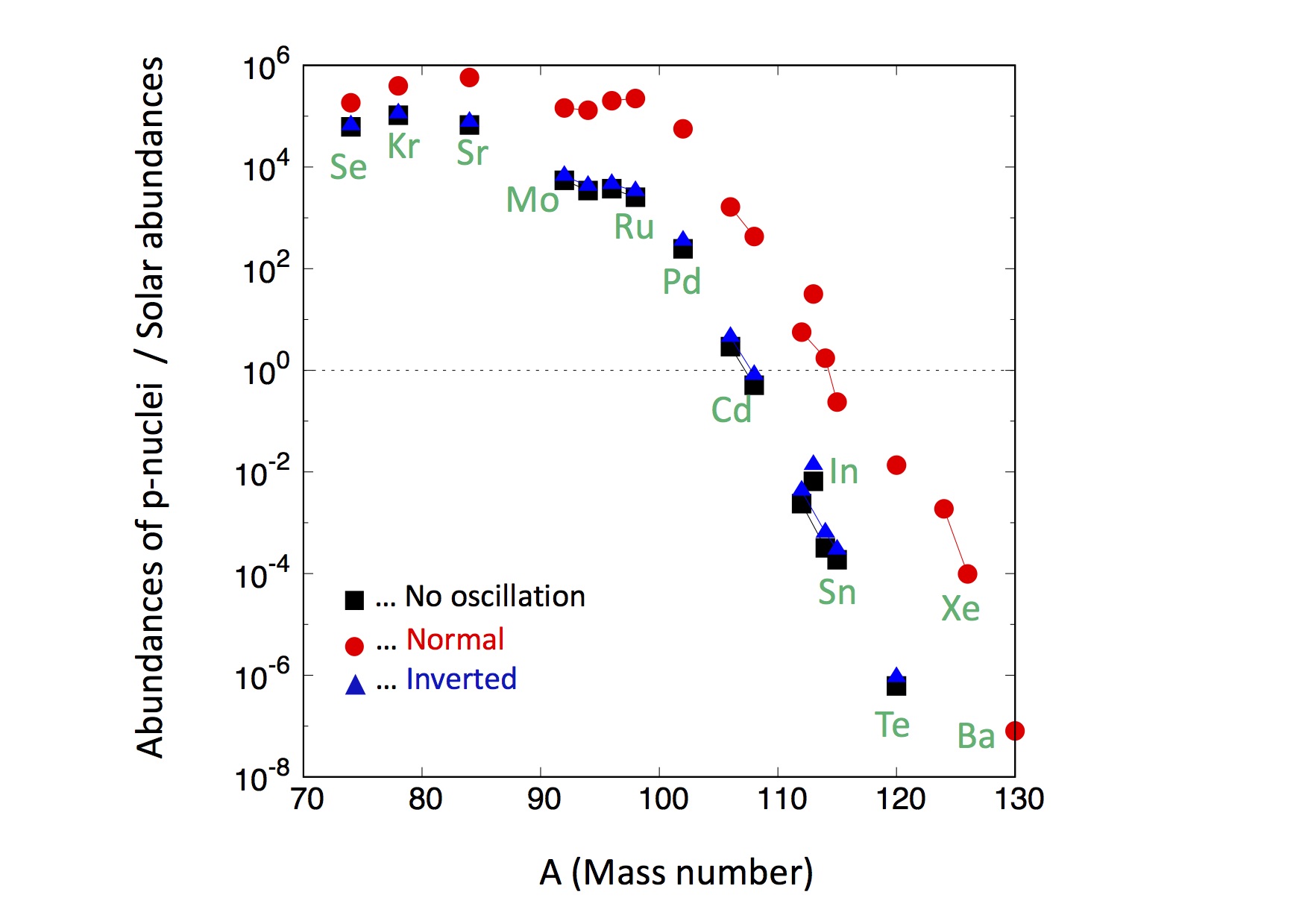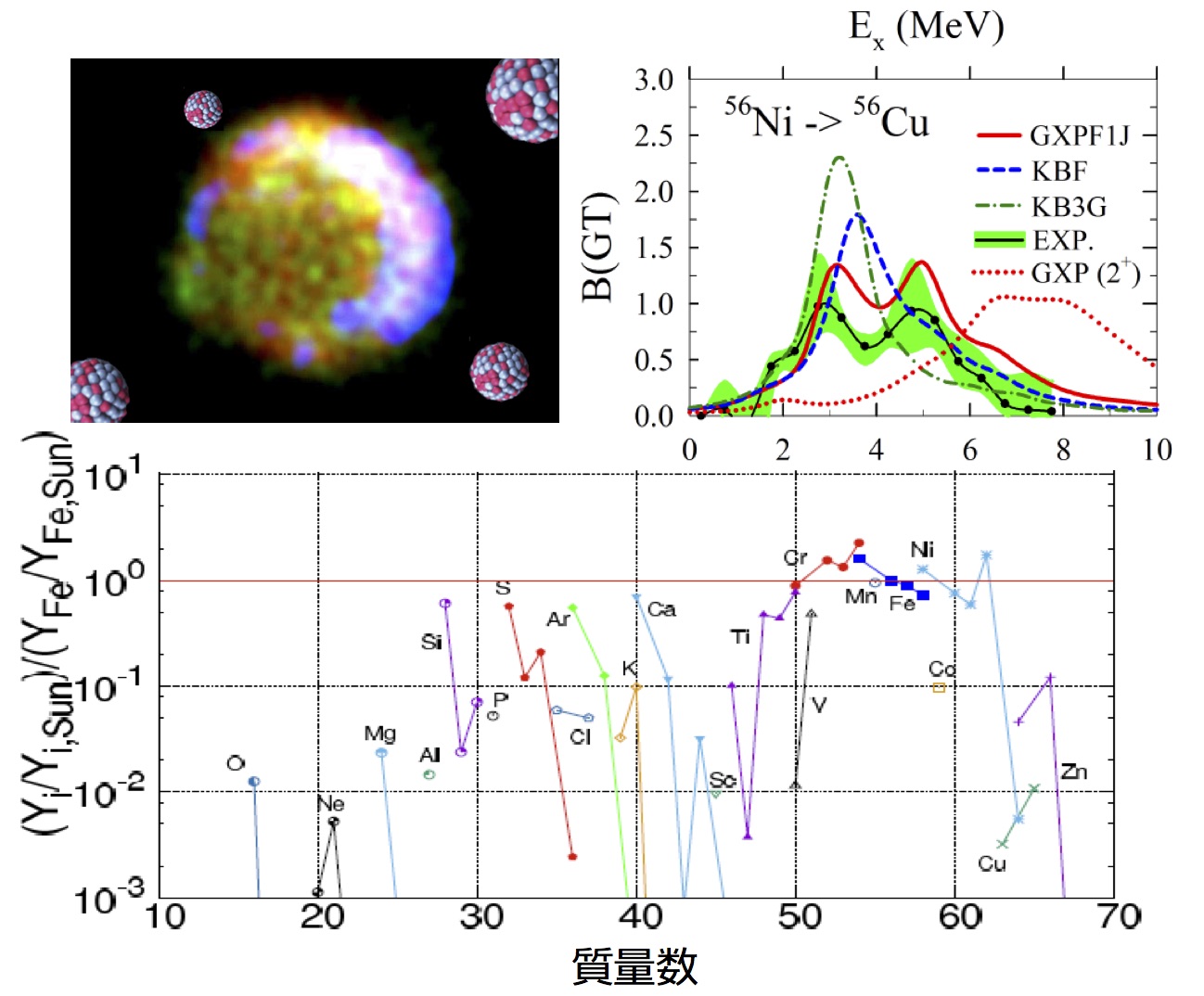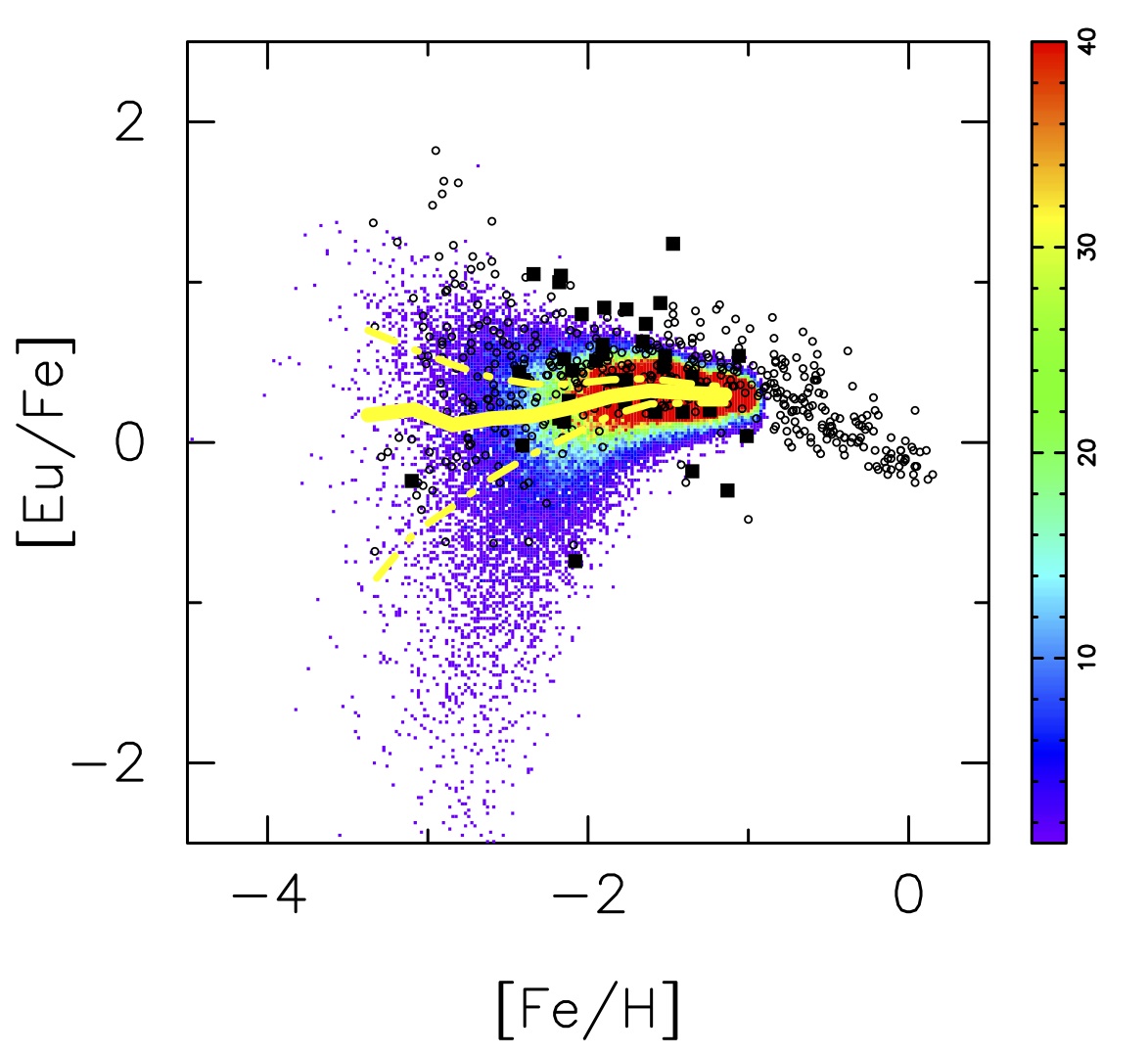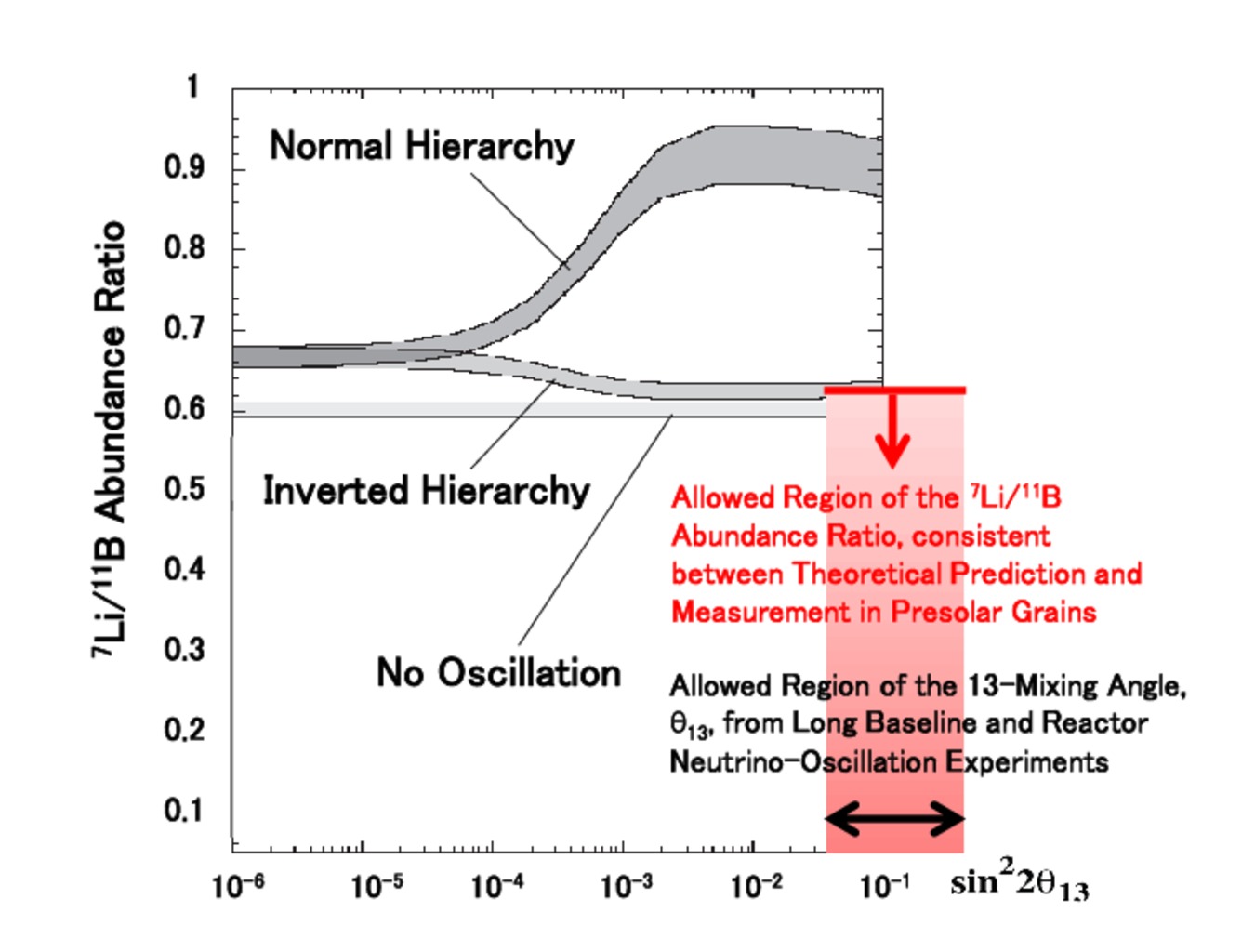The
effect of collective neutrino oscillations on vp process nucleosynthesis
In core
collapse supernovae, large numbers of neutrinos are emitted from the
protoneutron star after core bounce. At such high neutrino number
densities, neutrino-neutrino coherent scatterings cause a non-linear
phenomenon called "collective neutrino oscillation" which results in
the dramatic flavor transition in neutrino and antineutrino spectra.
There was no quantitative study which took into account the influence
of collective neutrino oscillations on the vp-process nucleosynthesis
consistently. In this work, we study the impact of collective neutrino
oscillations on the vp process nucleosynthesis by combining realistic
three flavor multiangle simulations with nucleosynthesis network
calculations for the first time. We find that the abundances of
p-nuclei which are synthesized in the vp process are enhanced by
oscillation effects by 10-104 times in normal
mass hierarchy. Our
results imply the necessity of collective neutrino oscillations for the
precise nucleosynthesis in neutrino-driven winds and also help
understand the origin of solar-system isotopic abundances of molybdenum
92, 94 and ruthenium 96, 98.

Figure: The abundances of p-nuclei inside neutrino-driven
winds which are normalized by solar isotopic abundances. In normal mass
hierarchy (red point), the abundances of p-nuclei are enhanced by
collective neutrino oscillations compared with no oscillation case
(black point).
"Possible effects of collective neutrino oscillations in three-flavor
multiangle simulations of supernova vp processes"
Hirokazu Sasaki, Toshitaka Kajino, Tomoya Takiwaki, Takehito Hayakawa,
Baha Balantekin, and Yamac Pehlivan 2017, Physical Review D, 96, 043013.
Efficiency
of Metal Mixing in Dwarf Galaxies
Dwarf
galaxies have the fewer number of stars with high r-process abundances
than those of the Milky Way halo. Metal mixing processes in the early
phase of galaxy formation deeply relate to these difference of the
elemental abundances. However, the efficiency of metal mixing in
galaxies is not yet understood. Here we performed a series of
chemodynamical simulations of dwarf galaxies with turbulence-induced
metal mixing model. We found that the efficiency of metal mixing is
larger than 1/10 of the efficiency estimated the turbulence theory. We
also found that timescale of metal mixing is less than 40 Myr. This
timescale is shorter than that of typical dynamical times of dwarf
galaxies.
Figure: [Ba/Fe] as a function of [Fe/H] of our model
prediction (color gradation) and observations of dwarf galaxies (dots).
Gray shaded region represents the region without observations. Left and
right panels show models with metal mixing timescale of 40 Myr and 1.6
Gyr, respectively.
“Efficiency of Metal Mixing in Dwarf Galaxies”
Yutaka Hirai, Takayuki R. Saitoh 2017, The Astrophysical Journal
Letters, 838, L23.
Mystery
of
Nucleosyntheis in Type Ia Supernova: Challenge from Precise Nuclear
Physics
Type
Ia supernovae (SNe Ia) are one of the most energetic phenomena in the
Universe, and have ever been used as cosmic ladder to discover the
accelerating cosmic expansion. However, the details of the explosion
mechanism are still unclear. Under an extremely high temperature and
density condition in the celestial phenomena like SNe Ia, electrons are
successively captured by radioactive nuclei and affect explosive
nucleosynthesis. Recent theoretical prediction of the electron capture
(EC) rates (i.e. equivalently Gamow-Teller strengths) of some unstable
nuclei has proved to be consistent with precise experimental
measurements. According to the theoretical prediction, the EC rates
differ from those used in the previous conventional calculations. In
the present study therefore we systematically calculate the EC rates
using new generation nuclear shell model, and apply the results to
network calculations of SN Ia nucleosynthesis. As a result, we find
that the overproduction problem in the abundances of neutron-excess
Cr-Fe-Ni isotopes is solved and that the solar-system abundances from
Si to Ni are well reproduced systematically in our late-detonation wind
model of SN Ia.

Figure:
(Upper left) Image of Tycho's supernova remnant taken by Suzaku (C)
RIKEN. (Upper right) Newly calculated Gamow-Teller strengths. (Lower)
Theoretical prediction of the isotopic abundances relative to the
solar-system abundances.
"Impact of New Gamow-Teller Strengths on Explosive Type Ia Supernova
Nucleosynthesis"
Kanji Mori et al., 2016, ApJ, 833, 179.
Early
evolutionary histories of galaxies deduced from r-process elements
Abundances
of r-process elements such as Eu and Ba in extremely metal-poor stars
may reflect the early evolutionary histories of galaxies. However, how
the chemo-dynamical evolution of galaxies affects the abundance of
r-process elements is not yet understood. In this study, we perform a
series of N-body/hydrodynamic simulations of galaxies with different
density and mass. We calculate the evolution of r-process abundances in
these galaxies. We find that galaxies with dynamical times around 100
Myr have star formation rates of less than 10-3
Msun/year
and they reproduce the observed r-process abundances (Figure A and B).
This result does not depend on the mass of halos. On the other hand,
r-process elements appear higher metallicity in galaxies with dynamical
times around 10 Myr (Figure C and D). We also find that galaxies with
lower star formation rates need longer timescale to mix metals,
resulting in larger dispersions of r-process abundance ratios. This
study demonstrates that future observations of r-process elements in
extremely metal-poor stars will be able to constrain the evolutionary
histories of galaxies.

Figure:
[Eu/Fe] as a function of [Fe/H]. Grey scale represents model
prediction. From left to right, we plot models with initial dynamical
times of 100 Myr (A), 70 Myr (B), 30 Myr (C and D). Model D has a
different density profile with other models. Small and large dots are
observed abundances in the Milky Way halo and dwarf galaxies.
“Early chemo-dynamical evolution of dwarf galaxies deduced from
enrichment of r-process elements”
Yutaka Hirai, Yuhri Ishimaru, Takayuki R. Saitoh, Michiko S. Fujii, Jun
Hidaka and Toshitaka Kajino
2017, Monthly Notices of Royal Astronomical Society, 466, 2474
An Elegant
Solution of the Big-Bang Lithium Problem?
The
success of a theory of the CMB fluctuation and anisotropies and the
observations of cosmic large-scale structure are thought to be a piece
of evidence that the Big-Bang theory, which was first proposed by
George Gamow in 1948, is the robust theoretical model of the cosmic
expansion. However, this model predicts too large primordial abundance
of lithium (atomic number Z=3) among all other light elements and
contradicts astronomical observations of the early generations of old
metal-poor stars. This discrepancy is called "the Big-Bang lithium
problem" which might indicate the breakdown of the standard Big-Bang
cosmology or suggest the need of a new particle-cosmological theory
beyond the standard model. Elementary particles and nuclei in the hot
Big-Bang expansion of the early Universe are not necessarily obey the
classical Maxwell-Boltzmann distribution but some other class of
non-extensive statistics. Tsallis statistics are the one of them which
is presumed to describe well the thermodynamic systems showing chaos or
fractals. Our international collaboration team demonstrated to solve
this long standing Big-Bang lithium problem by applying Tsallis
statistics to the primordial nucleosynthesis. If this "elegant
solution" is correct, the Big Bang theory is now one step closer to
fully describing the formation of our Universe, as referred in AAS NOVA.

Figure:
Primordial nucleosynthesis in the early hot Big-Bang expansion and the
evolution of the Universe (taken from AAS NOVA) (C) NASA.
"Non-extensive Statistics to the Cosmological Lithium Problem"
S. Q. Ho, et al. with T. Kajino 2017, Astrophys. J. 834, 165.
New
Model on
the Origin of the Heavy Elements, Solving the Underproduction Problem
of the r-Process
The
origin of heavy elements like gold and uranium, called r-process
elements, is one of the 11 Greatest Unanswered Questions of the Century
in Particle & Nuclear Physics and Astronomy (
http://discovermagazine.com/2002/feb/cover).
Shota Shibagaki and Taka Kajino in COSNAP International Consortium
proposed a new theoretical model that the r-process elements were
produced in supernova explosions from the early Galactic evolution,
followed later by the additional contribution from the binary
neutron-star mergers after 100 Myr of cosmic time. In this theoretical
model, a long-standing underproduction problem of the isotopic
abundances above and below the typical r-process peaks around A = 130,
165 and 195 is resolved, still satisfying the universal r-process
abundance pattern between the early generations of metal-deficient
stars and the solar-system.
Figure:
Solar-system isotopic r-prpcess abundance pattern. Observation (black
dots) vs. theoretical calculation which consists of the r-process in
magnetohydrodynamic jet supernova model (blue), neutrino-heated
supernova model (green), binary neutron-star merger model (red) and
total sum (black).
Relative contributions of the weak, main and fission-recycling r-process
S. Shibagaki, T. Kajino, G. J. Mathews, S. Chiba, S. Nishimura, and G.
Lorusso,
Astrophys. J. 816 (2016), 79.
Journal
arXiv
Origin of
r-process elements in galactic chemodynamical evolution
The
r-process is one of the main processes to synthesize elements heavier
than iron. The r-process elements have been observed in metal-poor
stars in dwarf galaxies and the Milky-Way halo, but astrophysical
site(s) of r-process is not identified yet. Nucleosynthesis
calculations suggest that binary neutron star mergers are the promising
astrophysical site of r-process. In contrast, galactic chemical
evolution studies without considering the formation process of galaxies
pointed out that it is difficult to reproduce the observed r-process
abundance in extremely metal-poor stars by neutron star mergers due to
their long merger time and low occurrence rate. In this study, we
performed a series of hydrodynamical simulations of dwarf galaxies
assuming that neutron star mergers are the major astrophysical site of
r-process. Our simulations reproduce the observed r-process abundance
in extremely metal-poor stars by neutron star mergers with merger time
of 100 Myr. In addition, we find that the metallicity is constant over
~ 300 Myr from the onset of star formation due to low star formation
efficiency in dwarf galaxies. We moreover find that metal mixing in
star-forming region avoids producing extremely r-process rich stars,
which are inconsistent with the observation, due to the low rate of
neutron star mergers. The r-process elements observed in the Milky-Way
halo might originate in accreted dwarf galaxies.

"Enrichment of r-process Elements in Dwarf Spheroidal Galaxies in
Chemo-dynamical Evolution Model”,
Yutaka Hirai, Yuhri Ishimaru, Takayuki R. Saitoh, Michiko S. Fujii, Jun
Hidaka and Toshitaka Kajino,
2015, The Astrophysical Journal, 814, 41
ADS
arXiv
Great
Progress towards the Origin
of R-process
International
collaboration team directed by Dr. G. Lorusso and Dr. S.
Nishimura (P.I., NAOJ visiting professor of 2013) at the RIKEN-Nishina
Center for
Accelerator-Based Science (chief scientist, Dr. H. Sakurai) produced
110 extremely
neutron-rich, heavy radioactive isotopes by using the world
highest-performance accelerator
at RIKEN-RIBF and succeeded for the first time in measuring their
beta-decay half-lives. Although these isotopes called
r-process elements are presumed to
originate in stellar explosions such as supernovae or binary
neutron-star mergers,
their astrophysical site has not yet been identified
uniquely. Mr.
S. Shibagaki (PhD graduate student) and Prof. T. Kajino in the Division
of Theoretical
Astronomy at NAOJ and the University of Tokyo applied these high
precision data to
the theoretical calculation of the r-process nucleosynthesis and
succeeded
in reproducing the observed abundances of heavy neutron-capture
elements
(i.e. r-process elements) consistent with those expected from the
core-collapse supernovae. It was also found that their supernova
r-process
calculation can explain the "universality" of the elemental-abundance
pattern (as a
function of atomic number) between the solar-system and the metal-poor
halo stars
which had been discovered by spectroscopic observations using SUBARU
and Hubble
Space Telescopes, etc. These results are published in
Physical
Review Letters, 2015 on line on May 11 (doi: 23.40.-s 26.30.Hj
27.60.+j).

(Right) Illustration of r-process nucleosynthesis in
core-collapse supernova explosion.
Credit: Akihiro Ikeshita / CG: Masayo Mikami (NAOJ Astronomy
Information Center)
(Left) "Universality" of the elemental-abundance pattern as a
function of atomic number Z between the solar-system and the metal-poor
halo
stars. Supernova r-process model can explain the
universality, except for a slight
deviation for the elements 50 < Z < 55, which was
discovered by
spectroscopic observations using SUBARU and Hubble Space Telescopes,
etc.
(Physical Review Letters, 2015, doi: 23.40.-s 26.30.Hj 27.60.+j)
Link to NAOJ
Link to RIKEN
(detail)
Quantum
theoretic approach to in-medium effects on the neutrino scattering
Neutrino
scattering provides a unique signal for understanding the weak
interaction processes in an extremely high-temperature and high-density
matter
inside the proto-neutron stars born in core-collapse supernova
explosions. COSNAP*
international collaboration group conducted by Prof. M.-K. Cheoun
(Soongsil Univ./NAOJ) and Prof. T. Kajino (NAOJ/Univ. of Tokyo) carried
out a quantum mechanical calculation of the neutrino scattering cross
sections on nucleons and nuclei at E < 100 GeV in the quark
meson
coupling
(QMC) model and compared the theoretical result with neutrino data
detected at
high-energy particle accelerators MiniBooNE and NOMAD. It is found that
below 1 GeV at
energies relevant for applications to the neutrino processes in the
supernova
matter, one needs to include nucleonic form factor and nuclear
structure effects as
well as the Fermi motion of nucleons.
The paper is selected as a highlight of Journal of Physics G and has
been taken in labtalk-article (http://iopscience.iop.org/0954-3899/labtalk-article/59987)
entitled "When and how do we include the in-medium effects in neutrino
scattering off target nuclei?". In this article both laboratories,
Prof. Cheoun's Labo
and Prof. Kajino's COSNAP* Labo, are introduced as active theory groups
that
continuously produce high-quality science papers.
This shows a schematic image that the high-energy neutrino beams from
accelerators like Fermilab MiniBooNE are unique experimental tools to
study the neutrino processes inside the proto-neutron stars born in
core-collapse
supernova explosions. The inset Figure shows that the degrees of
freedom of
strangeness make the important effects on the neutrino scattering cross
sections.
(Photograph are taken from http://www-boone.fnal.gov/virtual_tour/.)
M.-K. Cheoun, K.-S. Kim, H.-C. Kim, W.-Y. So, T. Maruyama and T. Kajino,
J. Phys. G42 (2015) 045102.
[http://iopscience.iop.org/0954-3899/42/4/045102/article]
A New
Production Mechanism for Ultra-High-Eneregy Cosmic Ray (UHECR) Neutrinos

T. Kajino,
A. Tokuhisa at NAOJ and The University of Tokyo and their
international collaboration team have recently proposed a new theory
for UHECR tau-neutrinos that could keep ultra-high energy > 1015
eV. Although two neutrino events, whose energies are higher than 1015
eV, were detected in IceCube Neutrino Observatory last year, origin of
the UHECR is still an unanswered
biggest mystery of the century. Although Ginzburg & Syrovatskii
(1965) and
Waxman & Bahcall (1997) theoretically proposed a model to
produce neutral mesons pi,
D_s, J/ψ as the source of high-energy neutrinos, they easily lose
energy during the
passage in space for relatively longer life, and neutrino energy cannot
be as high
as 1015
eV. Kajino and his collaborators discovered that the strong interaction
between UHECR hadrons like protons or irons can copiously produce heavy
neutral
mesons like upsilons in synchrotron emission near the strongly
magnetized neutron
star (i.e. magnetar) or active galactic nuclei (AGN), which quickly
decay to
produce tau-lepton pairs and create eventually UHECR tau-neutrinos.
T. Kajino, A. Tokuhisa, G. J. Mathews, T. Yoshida & M. A.
Famiano., Ap. J. 782 (2014), 70.
A New
Theoretical Method to determine the Unknown Neutrino Mass-Hierarchy
-- Selected
as A Highlight Topical Review of 2013 in Journal of Physics G --

Three
flavors of active (electron-, mu- and tau-type) neutrinos are
known to have finite masses and show the oscillation phenomena during
their passage
through space or matter inside the sun and supernovae (SNe). It is one
of the
ultimate purposes in modern physics and cosmology to determine their
masses and oscillation properties to construct a unified theory of
elementary
particles and fields beyond the standard model because neutrino mass is
the unique
experimental evidence which indicates the breakdown of the standard
model. There are
still two unknown parameters, i.e. the mass hierarchy (normal or
inverted) and
the CP violation phase. Toshio Suzuki (Nihon University/NAOJ) and
Toshitaka
Kajino (NAOJ) have proposed an astronomical method to determine the
mass hierarchy in
terms of SN nucleosynthesis of specific elements that were produced by
the
energetic neutrinos interacting with abundant nuclei inside the SNe
under the MSW
effects of neutrino oscillation. They also prove theoretically that the
proposed method is robust almost independent of the Hamiltonians
assumed in the
theoretical calculations of quantum neutrino-nucleus interaction
cross-sections.
This paper was selected as a highlight topical review of 2013 in
Journal of Physics G.
In the figure it is shown that the inverted mass hierarchy is
statistically more preferred from the comparison of the Li7/B11
abundance ratio between
theoretical prediction and observation from presolar grains which
originate from
SNe ejecta.
T. Suzuki and T. Kajino, J. Phys. G40 (2013), 083101.










